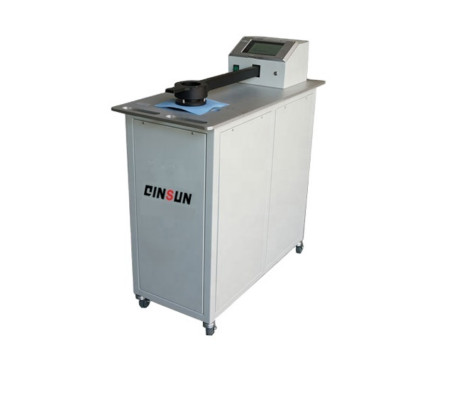Site: Home > Home > News and events
Diaper Permeability Tester is used for the determination of absorption speed, repermeability and permeability of diapers and other products.
Comply with standards: GB/T28004.1, GB/T28004.2-2021, etc.
Product features.
1、The test solution for testing is controlled by peristaltic pump to ensure the stability and repeatability of liquid addition, and the accuracy of liquid addition can reach ±1%.
2、The test solution (saline) is heated by water bath and stored in the glass irrigation, which will not have any effect on the performance of the test solution.
3、Children's diaper test sample fixture: 3 U-shaped bases, 3 sample holders, 3 standard liquid filling modules, 3 standard pressurization modules.
4、Adult diaper test sample fixture: 1 U-type base, 2 standard liquid filling modules, 2 standard pressurization modules.
5、All the sample jigs are made of PA66 material by 3D printing, with strong impact resistance, corrosion resistance and high temperature resistance.
6、The whole machine is designed with desktop structure, stable operation and more convenient to move and install.
7、The main control adopts STMicroelectronics 32-bit MCU, which can be equipped with Internet of Things function and facilitate data access to customer ERP system.
8、Using touch screen control and display, Chinese and English interface menu type operation.

Measurement method of permeability performance.
The specimen is placed on the curved specimen base lined with absorbent paper, and the standard test spiking module is placed on the absorbent area of the specimen surface. Each specimen was added twice, and the absorption rate of the specimen was expressed in terms of the two absorption times. After the second addition is completed, the standard test spiking module is removed, a certain number of layers of absorbent paper is placed on the surface of the specimen, and then the standard test spiking module is placed, and the specimen is pressurized under a certain pressure for a specified period of time, and the increase in the mass of absorbent paper on top of the specimen is used to indicate the amount of reperfusion of the specimen, and the increase in the mass of absorbent paper at the bottom of the specimen is used to indicate the amount of leakage of the specimen.
Technical parameters
1、Dimensions of children's diaper test parameters
1.1, U-type specimen base parameters.
B1: L:125±1mm W:122±1mm
B2: L:136±1mm W:135±1mm
B3: L:154±1mm W:152±1mm
1.2. Standard liquid filling module parameters.
M1: L:100±1mm W:80±1mm
M2: L:108±1mm W:85±1mm
M3: L:125±1mm W:95±1mm
1.3. Standard test pressurization module.
Y1: L:100±1mm W:80±1mm
Y2: L:108±1mm W:85±1mm
Y3: L:125±1mm W:95±1mm
2、Adult diaper test parameter size
2.1, U-type specimen base parameters.
L:319±1mm W:200±1mm
2.2、Standard liquid filling module parameters.
M1: L:170±1mm W:70±1mm
M2: L:170±1mm W:95±1mm
2.3、Standard test pressurization module.
Y1: L:170±1mm W:70±1mm
Y2: L:170±1mm W:95±1mm
3, pressurization pressure: 2.0±0.2 KPa, 4.0±0.2 KPa
4、Fluid flow rate: 480±5 ml/min (children), 750±5 ml/min (adults)
5、Timing range: 0.00 ~ 9999.99 s
6, test liquid heating range: room temperature +5 ℃ ~ 50 ℃
7, power supply: AC220V, 200W, 50Hz
8, size L × W × H: 320mm × 220mm × 500mm
Absorption multiplier
Take a piece of specimen, tear off the release paper, cut off the wings appropriately (trouser diapers need to cut the waist elastic band), and weigh its mass with a balance of 0.01 g sensitivity (quality before absorption). Clamp one end of the sample with a clip so that the clip opening is perpendicular to the longitudinal direction of the sample and should not catch the built-in absorbent layer. Immerse the specimen with the clamp in saline at a depth of approximately 10 cm (23 di 1)°C, with the use side of the specimen facing down. The specimen is gently pressed down and allowed to 'fully submerge' for 60 s. The clamp is then lifted so that the specimen is completely out of the water and suspended vertically for 90 s. Remove the clamp, weigh the mass of the specimen after absorption (mass after absorption), and calculate the absorption according to formula (3). Test five specimens in the same way, and take the average value of five specimens as the measurement result, trimmed to one decimal point. t - Absorption multiplicity; mass after absorption. The unit is gram (g); the mass before absorption. The unit is gram (g).
Saturation absorption
Take a specimen and weigh its mass (pre-absorption mass) with a balance of 0.1 g. Cut the elastic band at the waist (pants diaper). Immerse the specimen in saline at a liquid depth of not less than 10 cm at 20.0 °C to 28.0 °C with the use side of the specimen facing downwards. Gently press the specimen while immersed to remove air. The specimen is then lifted with both hands so that the specimen is completely out of the water and placed face down on a horizontal bar with the length of the specimen perpendicular to the bar and the diameter of the bar is (20 work 3)rnrn. After hanging for 5 min, the mass of the absorbed specimen is weighed (post-absorption mass) and the absorption is calculated according to equation (4). Test five specimens in the same way and take the average value of the five specimens as the measurement result, modifying to the whole number of digits.
Welcome to buy the diaper Permeability Tester if you have the need to leave a message to buy!
Copyright 2022:Qinsun Instruments Co., Limited
High-end textile tester supplier Email:info@qinsun-lab.com | Textile Testing Equipment pdf | Tel:021-67800179 |